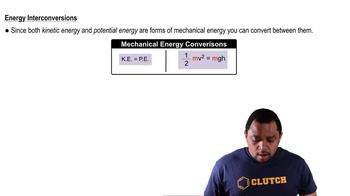Two positively charged particles are first brought close together and then released. Once released, the repulsion between particles causes them to move away from each other. (a) This is an example of potential energy being converted into what form of energy?
What is the kinetic energy and velocity of the aluminum sphere in Problem 1.4 at the moment it hits the ground? (Assume that energy is conserved during the fall and that 100% of the sphere's initial potential energy is converted to kinetic energy by the time impact occurs.)
 Verified step by step guidance
Verified step by step guidance
Verified video answer for a similar problem:
Key Concepts
Kinetic Energy

Potential Energy

Conservation of Energy

Two positively charged particles are first brought close together and then released. Once released, the repulsion between particles causes them to move away from each other. (b) Does the potential energy of the two particles prior to release increase or decrease as the distance between them is increased.
For each of the following processes, does the potential energy of the object(s) increase or decrease? (b) Water is pumped from ground level to the reservoir of a water tower 30 m above the ground.
Convert the following expressions into exponential notation: (a) 3 terameters (tm)
Convert the following expressions into exponential notation: (b) 2.5 femtoseconds (fs) (c) 57 micrometers (mm)
Convert the following expressions into exponential notation: (d) 8.3 megagrams (mg).
